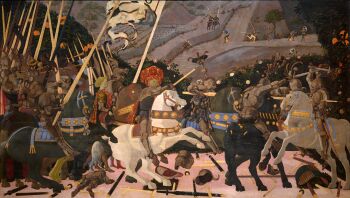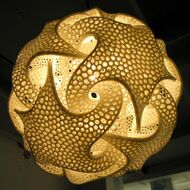List of mathematical artists
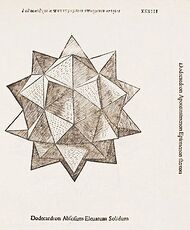
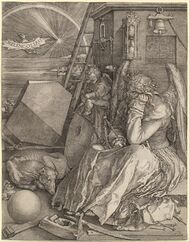
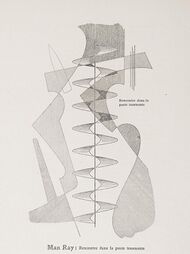


This is a list of artists who actively explored mathematics in their artworks.[3] Art forms practised by these artists include painting, sculpture, architecture, textiles and origami.
Some artists such as Piero della Francesca and Luca Pacioli went so far as to write books on mathematics in art. Della Francesca wrote books on solid geometry and the emerging field of perspective, including De Prospectiva Pingendi (On Perspective for Painting), Trattato d’Abaco (Abacus Treatise), and De corporibus regularibus (Regular Solids),[4][5][6] while Pacioli wrote De divina proportione (On Divine Proportion), with illustrations by Leonardo da Vinci, at the end of the fifteenth century.[7]
Merely making accepted use of some aspect of mathematics such as perspective does not qualify an artist for admission to this list.
The term "fine art" is used conventionally to cover the output of artists who produce a combination of paintings, drawings and sculptures.
List
| Artist | Dates | Artform | Contribution to mathematical art |
|---|---|---|---|
| Calatrava, Santiago | 1951– | Architecture | Mathematically-based architecture[3][8] |
| Demaine, Erik and Martin | 1981– | Origami | "Computational origami": mathematical curved surfaces in self-folding paper sculptures[9][10][11] |
| Dietz, Ada | 1882–1950 | Textiles | Weaving patterns based on the expansion of multivariate polynomials[12] |
| Draves, Scott | 1968– | Digital art | Video art, VJing[13][14][15][16][17] |
| Dürer, Albrecht | 1471–1528 | Fine art | Mathematical theory of proportion[18][19] |
| Ernest, John | 1922–1994 | Fine art | Use of group theory, self-replicating shapes in art[20][21] |
| Escher, M. C. | 1898–1972 | Fine art | Exploration of tessellations, hyperbolic geometry, assisted by the geometer H. S. M. Coxeter[18][22] |
| Farmanfarmaian, Monir | 1922–2019 | Fine art | Geometric constructions exploring the infinite, especially mirror mosaics[23] |
| Ferguson, Helaman | 1940– | Digital art | Algorist, Digital artist[3] |
| Forakis, Peter | 1927–2009 | Sculpture | Pioneer of geometric forms in sculpture[24][25] |
| Grossman, Bathsheba | 1966– | Sculpture | Sculpture based on mathematical structures[26][27] |
| Hart, George W. | 1955– | Sculpture | Sculptures of 3-dimensional tessellations (lattices)[3][28][29] |
| Radoslav Rochallyi | 1980– | Fine art | Equations-inspired mathematical visual art including mathematical structures.[30][31] |
| Hill, Anthony | 1930– | Fine art | Geometric abstraction in Constructivist art[32][33] |
| Leonardo da Vinci | 1452–1519 | Fine art | Mathematically-inspired proportion, including golden ratio (used as golden rectangles)[18][34] |
| Longhurst, Robert | 1949– | Sculpture | Sculptures of minimal surfaces, saddle surfaces, and other mathematical concepts[35] |
| Man Ray | 1890–1976 | Fine art | Photographs and paintings of mathematical models in Dada and Surrealist art[36] |
| Naderi Yeganeh, Hamid | 1990– | Fine art | Exploration of tessellations (resembling rep-tiles)[37][38] |
| Pacioli, Luca | 1447–1517 | Fine art | Polyhedra (e.g. rhombicuboctahedron) in Renaissance art;[18][39] proportion, in his book De divina proportione |
| Perry, Charles O. | 1929–2011 | Sculpture | Mathematically-inspired sculpture[3][40][41] |
| Robbin, Tony | 1943– | Fine art | Painting, sculpture and computer visualizations of four-dimensional geometry[42] |
| Saiers, Nelson | 2014– | Fine art | Mathematical concepts (toposes, Brown representability, Euler's identity, etc) play a central role in his artwork.[43][44][45] |
| Séquin, Carlo | 1941– | Digital art | computer graphics, geometric modelling, and sculpture[46][47][48] |
| Sugimoto, Hiroshi | 1948– | Photography, sculpture |
Photography and sculptures of mathematical models,[49] inspired by the work of Man Ray [50] and Marcel Duchamp[51][52] |
| Taimina, Daina | 1954– | Textiles | Crochets of hyperbolic space[53] |
| Thorsteinn, Einar | 1942–2015 | Architecture | Mathematically-inspired sculpture and architecture with polyhedral, spherical shapes and tensile structures [54][55] |
| Uccello, Paolo | 1397–1475 | Fine art | Innovative use of perspective grid, objects as mathematical solids (e.g. lances as cones)[56][57] |
| Kosmalski, Mikołaj Jakub | 1986 | Digital art | Exploration of spreadsheet software capabilities (OO Calc and MS Excel), generation of finite sets of points by parametric formulas, connecting these points by curved (usually cubic) and broken lines.[58] |
| Verhoeff, Jacobus | 1927–2018 | Sculpture | Escher-inspired mathematical sculptures such as lattice configurations and fractal formations[3][59] |
| Widmark, Anduriel | 1987– | Sculpture | Geometric glass sculpture using tetrastix, and knot theory[60][61] |
References
- ↑ Benford, Susan. "Famous Paintings: The Battle of San Romano". http://www.themasterpiececards.com/famous-paintings-reviewed/bid/27919/Famous-Paintings-The-Battle-of-San-Romano.
- ↑ "Mathematical Imagery: Mathematical Concepts Illustrated by Hamid Naderi Yeganeh". American Mathematical Society. https://www.ams.org/mathimagery/thumbnails.php?album=40.
- ↑ 3.0 3.1 3.2 3.3 3.4 3.5 "Monthly essays on mathematical topics: Mathematics and Art". American Mathematical Society. https://www.ams.org/samplings/feature-column/fcarc-art4.
- ↑ Piero della Francesca, De Prospectiva Pingendi, ed. G. Nicco Fasola, 2 vols., Florence (1942).
- ↑ Piero della Francesca, Trattato d'Abaco, ed. G. Arrighi, Pisa (1970).
- ↑ Piero della Francesca, L'opera "De corporibus regularibus" di Pietro Franceschi detto della Francesca usurpata da Fra Luca Pacioli, ed. G. Mancini, Rome, (1916).
- ↑ Swetz, Frank J.; Katz, Victor J.. "Mathematical Treasures - De Divina Proportione, by Luca Pacioli". Mathematical Association of America. http://www.maa.org/publications/periodicals/convergence/mathematical-treasures-de-divina-proportione-by-luca-pacioli.
- ↑ Greene, Robert (20 January 2013). "How Santiago Calatrava blurred the lines between architecture and engineering to make buildings move". Arch daily. http://www.archdaily.com/321403/how-santiago-calatrava-blurred-the-lines-between-architecture-and-engineering-to-make-buildings-move/.
- ↑ Yuan, Elizabeth (2 July 2014). "Video: Origami Artists Don't Fold Under Pressure". The Wall Street Journal. https://blogs.wsj.com/metropolis/2014/07/02/video-origami-artists-dont-fold-under-pressure/.
- ↑ Demaine, Erik; Demaine, Martin. "Curved-Crease Sculpture". http://erikdemaine.org/curved/.
- ↑ "Erik Demaine and Martin Demaine". Museum of Modern Art. http://www.moma.org/collection//browse_results.php?object_id=110195.
- ↑ Dietz, Ada K. (1949). Algebraic Expressions in Handwoven Textiles. Louisville, Kentucky: The Little Loomhouse. http://www.cs.arizona.edu/patterns/weaving/monographs/dak_alge.pdf. Retrieved 2015-06-07.
- ↑ Birch, K. (20 August 2007). "Cogito Interview: Damien Jones, Fractal Artist". http://www.cogito.org/Interviews/InterviewsDetail.aspx?ContentID=16808.
- ↑ Bamberger, A. (2007-01-18). "San Francisco Art Galleries - Openings". http://www.artbusiness.com/1open/011807.html.
- ↑ "Gallery representing Draves' video art". http://www.baxterchangpatri.com/artwork.html.
- ↑ "VJ: It's not a disease". Keyboard Magazine. April 2005. http://www.keyboardmag.com/article/vj-its-not/apr-05/7446.
- ↑ Wilkinson, Alec (2004-06-07). "Incomprehensible". New Yorker Magazine. http://www.newyorker.com/archive/2004/06/07/040607ta_talk_wilkinson.
- ↑ 18.0 18.1 18.2 18.3 "Feature Column from the AMS". American Mathematical Society. https://www.ams.org/samplings/feature-column/fcarc-art1.
- ↑ "Albrecht Dürer". University of St Andrews. http://www-history.mcs.st-and.ac.uk/Biographies/Durer.html.
- ↑ Beineke, Lowell; Wilson, Robin (2010). "The Early History of the Brick Factory Problem". The Mathematical Intelligencer 32 (2): 41–48. doi:10.1007/s00283-009-9120-4.
- ↑ Ernest, Paul. "John Ernest, A Mathematical Artist". University of Exeter. http://people.exeter.ac.uk/PErnest/pome24/ernest_john_ernest_a_mathematical_artist.doc.
- ↑ "M.C. Escher and Hyperbolic Geometry". The Math Explorers' Club. 2009. http://www.math.cornell.edu/~mec/Winter2009/Mihai/.
- ↑ "BBC 100 Women 2015: Iranian artist Monir Farmanfarmaian". BBC. 26 November 2015. https://www.bbc.co.uk/news/world-34921446.
- ↑ Smith, Roberta (17 December 2009). "Peter Forakis, a Sculptor of Geometric Forms, Is Dead at 82". The New York Times. https://www.nytimes.com/2009/12/16/arts/design/16forakis.html. "Often consisting of repeating, flattened volumes tilted on a corner, Mr. Forakis’s work had a mathematical demeanor; sometimes it evoked the black, chunky forms of the Minimalist sculptor Tony Smith."
- ↑ "Peter Forakis, Originator of Geometry-Based Sculpture, Dies at 82". Art Daily. http://artdaily.com/news/34722/Peter-Forakis--Originator-of-Geometry-Based-Sculpture--Dies-at-82#.VXRbbUZ0dIQ.
- ↑ "The Math Geek Holiday Gift Guide". Scientific American. November 23, 2014. http://blogs.scientificamerican.com/roots-of-unity/the-math-geek-holiday-gift-guide/.
- ↑ Hanna, Raven. "Gallery: Bathsheba Grossman". Symmetry Magazine. http://www.symmetrymagazine.org/article/september-2005/gallery-bathsheba-grossman.
- ↑ "George W. Hart". Bridges Math Art. http://www.bridgesmathart.org/art-exhibits/jmm09/hart.html.
- ↑ "George Hart". Simons Foundation. https://www.simonsfoundation.org/authors/george-hart/.
- ↑ Rochallyi, Radoslav (2021). "EQUATION POETRY". in Deanna Haunsperger (in en). Washington D.C.: Mathematical Association of America. https://www.mathvalues.org/masterblog/equation-poetry.
- ↑ Lorenzo Bartolucci, Katherine G. T. Whatley, ed (2021-05-08). "The World Pretends to Be Burning". Mantis, Stanford Journal of Poetry, Criticism, and Translations. (Stanford University) (19): 128. ISSN 1540-4544. OCLC 49879239.
- ↑ "Anthony Hill". Artimage. https://artimage.org.uk/artists/h/hill-anthony/.
- ↑ "Anthony Hill: Relief Construction 1960-2". Tate Gallery. http://www.tate.org.uk/art/artworks/hill-relief-construction-t00567. "The artist has suggested that his constructions can best be described in mathematical terminology, thus ‘the theme involves a module, partition and a progression’ which ‘accounts for the disposition of the five white areas and permuted positioning of the groups of angle sections’. (Letter of 24 March 1963.)"
- ↑ "Leonardo DaVinci and the Golden Section". University of Regina. http://mathcentral.uregina.ca/beyond/articles/Art/DaVinci.html.
- ↑ Friedman, Nathaniel (July 2007). "Robert Longhurst: Three Sculptures". Hyperseeing: 9–12. "The surfaces [of Longhurst's sculptures] generally have appealing sections with negative curvature (saddle surfaces). This is a natural intuitive result of Longhurst's feeling for satisfying shape rather than a mathematically deduced result.".
- ↑ "Man Ray–Human Equations A Journey from Mathematics to Shakespeare February 7 - May 10, 2015". Phillips Collection. http://www.phillipscollection.org/events/2015-02-07-exhibition-man-ray-human-equations.
- ↑ Bellos, Alex (24 February 2015). "Catch of the day: mathematician nets weird, complex fish". The Guardian. https://www.theguardian.com/science/alexs-adventures-in-numberland/2015/feb/24/catch-of-the-day-mathematician-nets-weird-complex-fish.
- ↑ "Continents, Math Explorers' Club, and "I use math for…"". mathmunch.org. April 2015. http://mathmunch.org/2015/04/15/continents-math-explorers-club-and-i-use-math-for/.
- ↑ Hart, George. "Luca Pacioli's Polyhedra". http://www.georgehart.com/virtual-polyhedra/pacioli.html.
- ↑ "Dodecahedron". Wolfram MathWorld. http://mathworld.wolfram.com/Dodecahedron.html.
- ↑ William Grimes (11 February 2011). "Charles O. Perry Dies at 81; Sculptor Inspired by Geometry". New York Times. https://www.nytimes.com/2011/02/11/arts/design/11perry.html?_r=1&ref=obituaries.
- ↑ Radcliff, Carter; Kozloff, Joyce; Kushner, Robert (2011). Tony Robbin: A Retrospective. Hudson Hills Press. ISBN 978-1-555-95367-6.
- ↑ levi, ryan. "Alcatraz Displays Irrational Numbers & Irrationally Long Prison Sentences". https://www.kqed.org/arts/12603270/alcatraz-displays-irrational-numbers-irrationally-long-prison-sentences.
- ↑ Mastroianni, brian (26 May 2015). "The perfect equation: Artist combines math and art". https://www.foxnews.com/science/the-perfect-equation-artist-combines-math-and-art.
- ↑ Dietrich, Chris (April 2, 2016). "A Hedge Funder's Merger of Aesthetics and Math". https://www.barrons.com/articles/a-hedge-funders-merger-1459570721.
- ↑ "Carlo H. Séquin | EECS at UC Berkeley". Eecs.berkeley.edu. 2015-02-21. http://www.eecs.berkeley.edu/Faculty/Homepages/sequin.html. Retrieved 2015-03-02.
- ↑ "curriculum vitae: Carlo H Sequin". Cs.berkeley.edu. http://www.cs.berkeley.edu/~sequin/BIO/curvitae.html. Retrieved 2015-03-02.
- ↑ Séquin, Carlo. "Carlo Séquin | Mathematical Art Galleries". http://gallery.bridgesmathart.org/exhibitions/2020-bridges-conference/sequin.
- ↑ "Portfolio Slideshow (Mathematical Forms)". New York Times. https://www.nytimes.com/slideshow/2004/12/02/magazine/20041205_PORTFOLIO_SLIDESHOW_1.html?_r=0. "Mathematical Form 0009: Conic surface of revolution with constant negative curvature. x = a sinh v cos u; y = a sinh v sin u; z = ..."
- ↑ "Hiroshi Sugimoto: Conceptual Forms and Mathematical Models". Phillips Collection. http://www.phillipscollection.org/events/2015-02-07-exhibition-hiroshi-sugimoto.
- ↑ "Hiroshi Sugimoto". Gagosian Gallery. http://www.gagosian.com/artists/hiroshi-sugimoto/. "Conceptual Forms (Hypotrochoid), 2004 Gelatin silver print"
- ↑ "art21: Hiroshi Sugimoto". PBS. http://ec2-75-101-145-29.compute-1.amazonaws.com/art21/artists/hiroshi-sugimoto.
- ↑ "A Cuddly, Crocheted Klein Quartic Curve". Scientific American. 17 November 2013. http://blogs.scientificamerican.com/roots-of-unity/a-cuddly-crocheted-klein-quartic-curve/.
- ↑ Wisniewski, Katherine (May 6, 2015). "Architectural Mad Scientist Einar Thorsteinn Passes Away at 73". http://curbed.com/archives/2015/05/06/einar-thorstein-olafur-eliasson.php. Retrieved 12 May 2015.
- ↑ "Ingenuity - Einar Thorsteinn". Icelandic Times (7). 2011. http://iceland-times.com/section.php?id=3988&id_art=5272. Retrieved 14 May 2015.
- ↑ "Paolo Uccello". J. Paul Getty Museum. http://www.getty.edu/art/collection/artists/13825/paolo-uccello-italian-about-1397-1475/.
- ↑ "The Battle of San Romano, Paolo Uccello (c1435-60)". The Guardian. 29 March 2003. https://www.theguardian.com/culture/2003/mar/29/art. "it is his bold enjoyment of its mathematical development of shapes - the lances as long slender cones, the receding grid of broken arms on the ground, the wonderfully three-dimensional horses, the armoured men as systems of solids extrapolated in space - that makes this such a Renaissance masterpiece."
- ↑ Artmajeur - "Mikołaj Jakub Kosmalski. Artist's website at artmajeur.com.". https://www.artmajeur.com/pl/mikolajkosmalski/artworks.
- ↑ "Koos Verhoeff - mathematical art". Ars et Mathesis. http://www.arsetmathesis.nl/verhoeff.htm.
- ↑ Widmark, Anduriel (2 April 2020). "Stixhexaknot: a symmetric cylinder arrangement of knotted glass". Journal of Mathematics and the Arts 14 (1–2): 167–169. doi:10.1080/17513472.2020.1734517. https://doi.org/10.1080%2F17513472.2020.1734517.
- ↑ Widmark, Anduriel (1 July 2021) (in en). Sculpture Design with Hexastix and Related Non-Intersecting Cylinder Packings. pp. 293–296. ISBN 9781938664397. https://archive.bridgesmathart.org/2021/bridges2021-293.html.
External links
 |
